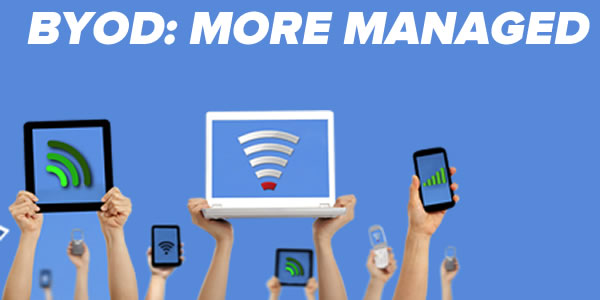
The London-based IT/telecom analyst firm Ovum have highlighted five trends for the coming year based on their 2015 Trends to Watch: Enterprise Mobility report. They expect that enterprise mobility will continue to be one of the hottest IT topics, and that these trends — which we’ve summarized below — will have the biggest impact on businesses in 2015:

Many IT departments still operate as if we’re still in the 1990s, when technology options were “trickle-down”, and people’s work technology options were wholly determined by IT. They’re still wrapping their heads around consumerization, the rapid changes in mobile technology, shrinking budgets, and employees who want more say in the technology they use to get their jobs done. Ovum predict that this situation — a mismatch between what companies are providing and what their employees want in mobile technologies and their use — will continue for some time.

According to Ovum’s report, BYOD will start its evolution from informal and unmanaged to taking a more formal, managed approach. This change will be helped along by improvements in device management solutions and better support models and policies for the use of employee-liable devices for work. Companies with special security needs — financial organizations are one example — may choose to adopt a hybrid corporate-liable/employee-liable approach, where employees who access highly sensitive data and corporate resources on their mobiles do so on corporate-liable devices, while those who don’t are free to use their personal devices for work (with the requisite security measures in place, of course).

As a relatively new addition to most companies’ technology portfolios, mobile has been treated as an add-on rather than as a mainstay technology. At the start of the smartphone era, this approach made sense, but as we close in on the 8th year since the introduction of the iPhone, it’s time to treat mobile as a technology that’s just as essential to getting work done as desktops, laptops and servers. Ovum predict that many companies will treat enterprise mobility management (EMM) as part of a wider “workspace” strategy, with the goal of enabling employees to get their work done any time, anywhere, and on any device.

Mobile devices found their way into the workplace the same way that PCs did: through eager early adopters bringing personal technology that they loved to work. Senior execs eventually saw the benefits of these “toy machines” and got more involved in their proliferation in the workplace. Ovum believe that the same thing will happen with mobile in the workplace: once driven by passionate technology fans, its more formal adoption and deployment in the office will be increasingly influenced by bosses.

SMEs — small-and-medium-sized enterprises — and the vendors that sell to them should expect 2015 to be more mobile-centric, Ovum say. They see a “long tail” of demand for mobile devices and services from SMEs, but it’ll be tricky: SMEs generally don’t trust service providers when it comes to delivering IT services.

Taken together, the practical take-aways from these trends according to Ovum senior analyst Richard Absalom are:
- Just as companies stepped in and developed IT policies and practices for PCs after they grew from early-adopter rarities to office mainstays, they need to start to do the same for mobile devices if they haven’t done so already.
- Companies need to look for ways that mobile devices, apps, and services can efficiently and securely connect to corporate “endpoints”, ranging from email, contacts, and calendar to line of business applications, all in the service of enabling “any time, anywhere, and on any device” work.
- Mobile management providers will need to:
- Grow their selection of features and services. As mobile devices and apps become more sophisticated, carrier data offerings improve, mobile computing needs increase, and the trend towards outsourcing non-core competencies such as mobile IT continues, demand for mobile services will grow, and mobile service providers who capitalize on this trend early by having a wide array of offerings will reap the rewards.
- Build effective partnerships. Large global organizations are feeling the pain from all the changes that mobile technologies bring, but they won’t bring their problems to just anyone — they also need service that’s delivered continuously, consistently, and globally. One way for service providers to do this is to form partnerships that allow them to focus on their own strengths, while expanding their offering by capitalizing on their partners’ strengths.
